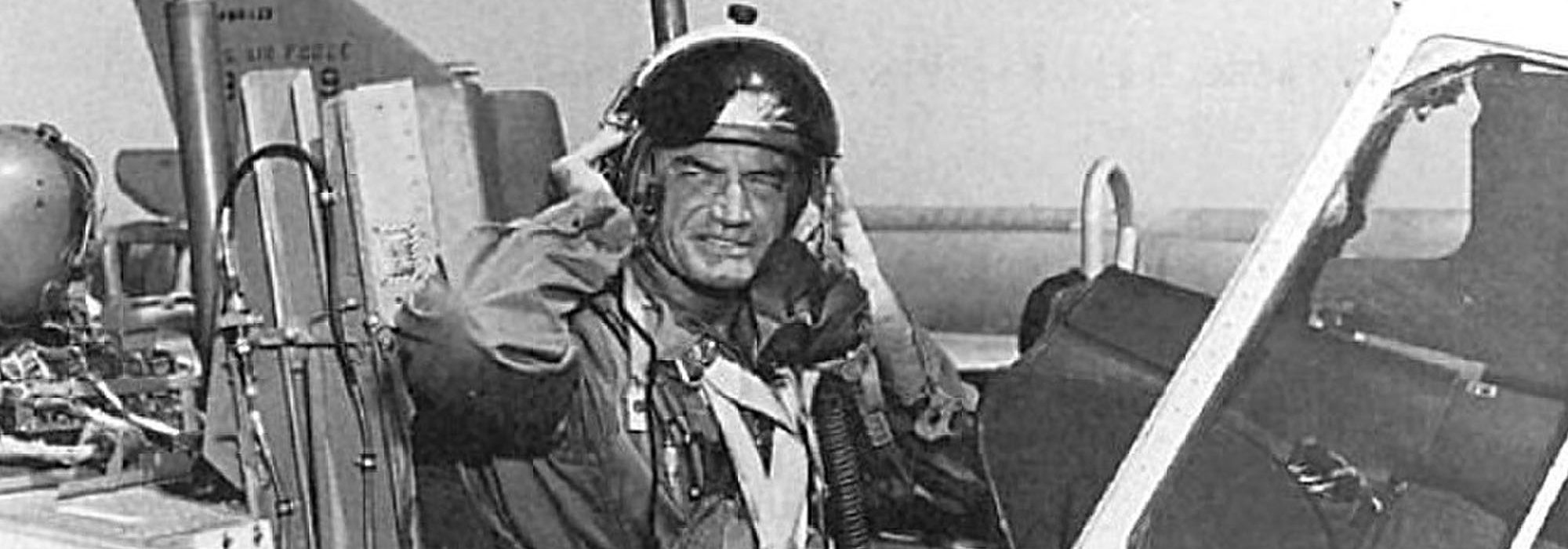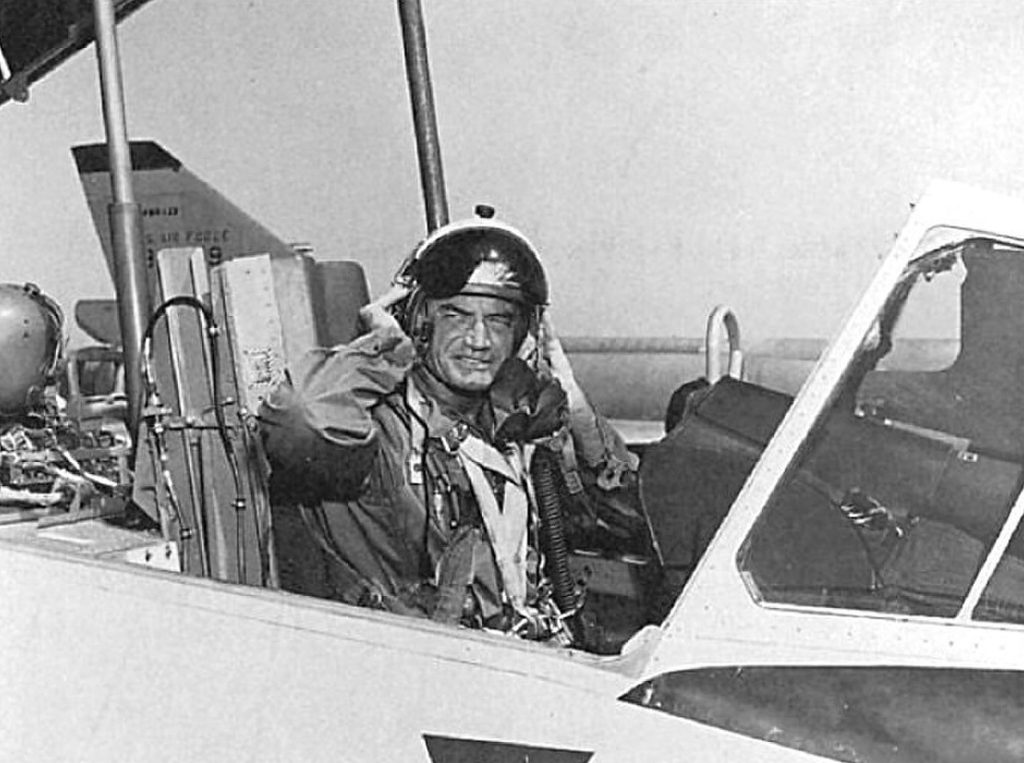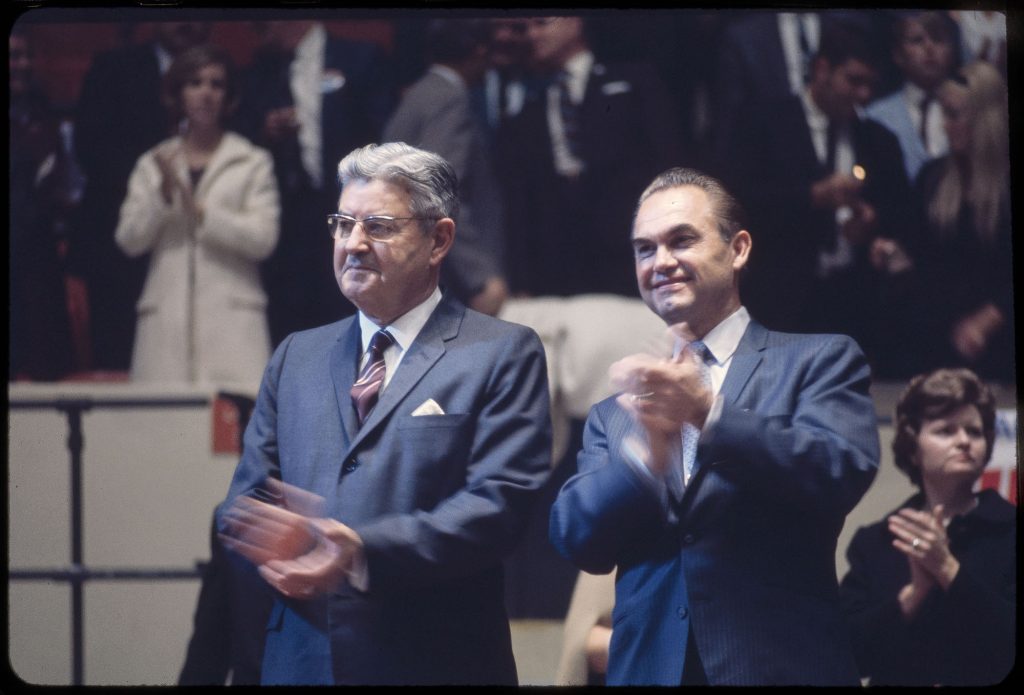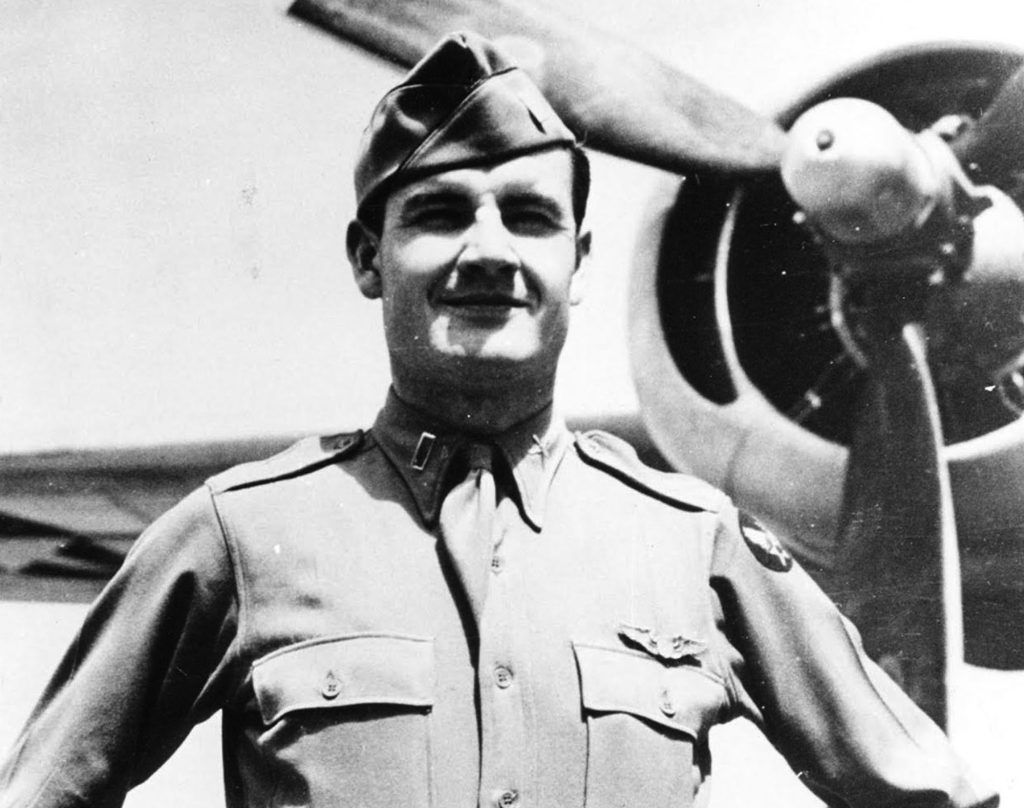Army Air Forces Vets ran for President in 1964, 1968, and 1972. None came close to winning.
Political historians would see little in common among the politics of Republican Barry Goldwater, the Arizona senator who ran and lost to Lyndon Johnson in 1964; George Wallace, the Alabama governor, whose American Independent Party candidacy in 1968 split the Democratic ticket and sent Richard Nixon to the White House; and Democrat George McGovern, the South Dakota senator who lost to Richard Nixon in 1972. All three ran under different party banners, but what they had in common was that all three were veterans of the U.S. Army Air Forces in World War II.
Goldwater flew military transports on long-range transoceanic flights from the United States to the China-Burma-India theater. Wallace was a flight engineer on B-29s on combat missions from Tinian to Japan and back in the Pacific theater. McGovern flew B-24 bombers on combat missions from Italy against Nazi targets in Europe. These military experiences were defining moments for each.
Every President of the United States from the end of World War II in 1945 to the end of the Cold War in the early 1990s was a military veteran. Besides Harry S. Truman, an Army National Guard artillery officer in World War I, the others were all World War II veterans: Dwight D. Eisenhower, John F. Kennedy, Lyndon B. Johnson, Richard Nixon, Gerald Ford, Jimmy Carter (who was at the U.S. Naval Academy during the war), Ronald Reagan, and George H. W. Bush. Among them, only Ronald Reagan was an Army Air Forces vet. Except for U.S. Army Gen. Dwight D. Eisenhower, the rest were Navy veterans.
Among the five Presidents since 1992, only George W. Bush, who was a pilot in the Air National Guard, served in the military. Bill Clinton, Barack Obama, Donald Trump, and Joe Biden did not.
The United States Air Force was not created as an independent service until 1947, two years after World War II ended. Before then, the Army Air Forces was subordinate to the Army, and it was a distinctive part of that service and crucial to the victory of Allied forces over Germany and Japan.
BARRY GOLDWATER
Barry Goldwater’s service in the Army Air Forces as a transport pilot was global and heroic. Having attended Staunton Military Academy in Virginia, Goldwater started attending the University of Arizona in 1928, but had to drop out when his father died to run his father’s store. The next year, he soloed as a civilian pilot, and obtained a commercial pilot’s license. He applied to train as a military pilot in the Air Corps but was rejected because of poor vision. In 1930, he joined the Army as an infantryman in the Reserve, serving in the 25th Infantry Division. During the 1930s, he continued flying private airplanes, accumulating 400 flying hours. In 1934, he married Margaret Johnson, whom he called Peggy.
In 1941, Goldwater visited Lt. Col. Ennis Whitehead at Luke Field, Ariz., and asked for a commission in the regular Army to serve in the Army Air Forces. Whitehead obliged, and Goldwater became the public relations director at Luke Field, with the rank of first lieutenant. He also coordinated the base supply system.
In July 1942, eight months after the bombing of Pearl Harbor and the U.S. entry into the war, Goldwater was assigned to flight training school at Yuma, Ariz., as an aerial gunnery instructor. He also photographed pilot cadets in exchange for their allowing him to fly some of the AT-6 advanced trainer aircraft, accumulating 200 hours of unofficial flying time.
In May 1943, Goldwater finally achieved his goal of becoming a military pilot. The Air Transport Command took pilots with poor vision, such as Goldwater, to help transport planes, equipment, and supplies to various airfields around the world. Goldwater, now a captain, became the operations officer of the 27th Ferrying Squadron. He was stationed at New Castle, just outside Wilmington, Del.
Five months later, Goldwater and nine other pilots joined in an operation known as “Snowball Run,” the first aerial ferrying of P-47 single-engine fighters from the United States to England, via Newfoundland, Greenland, Iceland, and Scotland. Goldwater informally named the P-47 he flew across the Atlantic the “Peggy G” after his wife. The flight covered more than 3,700 miles.
After returning from England on a C-87, Goldwater, as a chief pilot, ferried multi-engine aircraft, including medium bombers, from the United States to India, a distance of 10,000 miles—almost halfway around the world. The Crescent route went from the eastern United States to the Azores, then across northern Africa and the Middle East; the Fireball route went from Miami to Brazil, then across the Atlantic to Nigeria, and from there across Central Africa to India.
In one operation, Goldwater flew a four-engine C-54 loaded with two B-29 engines to a base in India. There he met Gen. Curtis E. LeMay, who helped direct forklifts to unload Goldwater’s plane. Goldwater and LeMay became friends at that time.
By February 1944, Goldwater was stationed in India, taking part in “Hump” flights over the Himalaya Mountains from India to China, transporting arms, ammunition, and other equipment and supplies to the forces of Generalissimo Chiang Kai-shek. On these missions, Goldwater flew C-46 twin-engine aircraft, usually landing at Kunming, China, from whence shuttle flights carried the cargo to other bases. Goldwater earned a promotion to major and not long after, to lieutenant colonel. In Burma, Goldwater helped train Chinese pilots to fly P-40 fighters.
In August 1944, after six months in the China-Burma-India theater, Goldwater returned to the United States. He was assigned to a flying training school in Southern California to train future fighter pilots and was there when the Japanese agreed to surrender in August 1945. Goldwater received an honorable discharge that November and returned to civilian life. He eventually went from the retail store business into Arizona politics, and soon helped found the Arizona Air National Guard.
GEORGE WALLACE
George Wallace was never a pilot but, unlike Goldwater, he flew combat missions. Wallace enlisted in the Army Air Forces at Tuscaloosa, Ala., on Oct. 20, 1942, but was not required to report for induction until January 1943. He did his basic training at Miami Beach, Fla., and was sent to Arkadelphia, Ark., for preliminary flight training, including academic courses, despite his already having obtained a law degree from the University of Alabama. But Wallace came down with spinal meningitis and was treated with sulfadiazine, a sulfa drug, to which he suffered an allergic reaction. While on temporary leave, Wallace returned to Tuscaloosa and married Lurleen Burns in May 1943, and then requested he be relieved from pilot training. He reported to Amarillo, Texas, for reassignment as an enlisted man and was transitioned to training as a flight engineer as a member of a B-29 bomber crew. The B-29 Superfortress was the largest, fastest, highest-flying, and longest-range bomber of World War II, with the largest bomb capacity. Wallace completed most of his training at Alamogordo, N.M., but also trained in Denver, and elsewhere. During this time, Wallace was promoted to sergeant.
In mid-June 1945, Wallace and his 11-man B-29 crew picked up a B-29 called “Sentimental Journey” at Topeka, Kan., and flew it via California and the Pacific Islands to the Mariana Islands, where he came under the command of LeMay in the XXI Bomber Command of the 20th Air Force. In Guam, Wallace and his crew transferred to another B-29, called the “Little Yutz,” and flew it on to the nearby island of Tinian, arriving on June 20. Wallace and his crew served in the 795th Bombardment Squadron, 468th Bombardment Group, of the 58th Wing of the 20th Air Force.
By the time Wallace arrived on Tinian, bombardment operations from there to Japan and back had become routine. LeMay had abandoned attempted high-level daylight precision attacks on Japanese military targets, which proved largely unsuccessful because of cloud cover and the jet stream and the extreme altitudes. Instead, he pursued a strategy of lower-level nighttime raids on Japanese cities, using incendiary bombs. The B-29s flew in huge formations on round-trip missions that sometimes lasted up to 18 hours, flying over the island of Iwo Jima on the way. As flight engineer, Wallace was responsible for controlling the fuel consumption of his Superfortress, to make sure the big plane retained enough fuel to make it all the way back to Tinian after a combat mission.
Wallace flew at least nine combat missions from Tinian in the “Little Yutz”—some of them harrowing and dangerous. They faced flak, enemy fighters, updrafts from huge fires, bad weather, and fatigue. All but one of the missions was a nighttime incendiary raid. Conscious of the massive fires these B-29 missions ignited, the men who flew them suffered a psychological toll. On one mission, two of the aircraft’s four engines quit, but Wallace was able to restart them. On another, one of the engines caught fire, but Wallace was able to extinguish the blaze. “Little Yutz” returned to Tinian on three engines, largely thanks to its flight engineer.
Wallace’s B-29 returned to Tinian from an overnight mission early on Aug. 6, 1945, unaware that another B-29, also based on Tinian, would drop an atomic bomb on Hiroshima, that day. He found out soon enough.
After returning from his final mission on Aug. 6, Wallace and his crew were ordered to embark on an air transport plane to California, landing at Mather Army Airfield. Granted leave, he took a train to Mobile to be with his wife and young daughter, where he was on Aug.14—“Victory over Japan Day” or “V-J Day”—when it was announced that Japan had agreed to surrender.
With World War II over, Wallace was eager to return to civilian life. He had lost weight and had become anxious, perhaps depressed. Ordered to report for additional flight crew training, he refused, and his commanding colonel sent him for medical evaluation. Doctors determined Wallace was not fit to fly, and he spent a month in a hospital. He received an honorable discharge on Dec. 8, 1945, at El Paso, Texas; the Veterans Administration eventually granted him a 10 percent disability rating.
Among his honors and decorations were credit for the Air Offensive, Japan campaign, an Air Medal, a Good Conduct Medal, and ribbons for the American theater and the Asiatic Pacific theater. He also received, along with tens of thousands of others, the World War II Victory medal.
In 1958, George Wallace ran but lost the race to be the Democratic candidate for governor of Alabama. Four years later, however, he won the governorship and soon set his sights higher. In 1963, having gained notoriety by challenging federal Civil Rights enforcement, he announced his intention to challenge President John F. Kennedy in the 1964 Democratic primaries. Wallace became a national symbol of Southern resistance to federal civil rights law. Although he later withdrew, it set the stage for his 1968 campaign, not as a Democrat, but as the candidate of the American Independent Party. His choice for running mate was his old superior in the Marianas, Curtis LeMay, who by then was a former Chief of Staff of the United States Air Force.
Precluded from running again for governor by Alabama law, Wallace backed his wife’s successful bid for the office in 1966, and then when that term ended, ran and won again in 1970. Two years later, he again sought the presidency, this time as a Democrat, his candidacy ending after he was shot in an assassination attempt while campaigning. He tried and failed a fourth time in 1976.
GEORGE McGOVERN
George McGovern was a bomber pilot in the Army Air Forces during World War II. McGovern flew B-24 Liberators and was a combat veteran.
Having already trained as a civilian pilot, McGovern completed primary flight training at Muscogee, Okla., basic at Coffeyville, Kan., and advanced flight training at Pampa, Texas, where he received his wings and commission as a second lieutenant in April 1944. McGovern then trained on the B-24 pilot at Liberal, Kan., and Mountain Home, Idaho. He met and married Eleanor Stegeberg during his early flight training.
In October 1944, McGovern voyaged to Italy and in November began flying combat missions, as a co-pilot on his first five missions, and later as pilot in charge for 30 missions more, all with the 741st Bombardment Squadron, 455th Bombardment Group, stationed at Cerignola, Italy. The 455th was one of 21 heavy bombardment groups of the Fifteenth Air Force in the Mediterranean theater.
Among McGovern’s 35 combat missions, most were long-range bombing raids against Nazi targets, including railroad yards, fuel refineries, airfields, bridges, and factories in Germany, Austria, Hungary, Italy, Czechoslovakia, and Poland. Two of those missions sought to damage a synthetic oil refinery near the Auschwitz death camp.
He had to overcome anti-aircraft artillery, enemy fighters, and bad weather. On one mission, McGovern’s B-24 blew a tire on takeoff, and he had to take extraordinary steps to land the plane safely on return; on another, an engine failure forced McGovern to make an emergency landing on the island of Vis in the Adriatic Sea, putting down on a small runway designed for fighters. His most challenging mission was his last, on April 25, 1945, when McGovern’s plane was peppered with flak during a raid on the railroad marshalling yards at Linz, Austria, but despite the plane’s heavy damage, McGovern managed to land it safely, saving the lives of everyone on board.
McGovern earned a Distinguished Flying Cross with three oak leaf clusters for his combat flying. According to Thomas J. Knock’s biography, “among presidential candidates of the 20th century, none save Eisenhower could boast a more impressive record” of military service. McGovern concluded his service in June 1945, flying a B-24 from Italy across the Atlantic Ocean to the United States, with stops at Morocco, the Azores, and Newfoundland, before landing at Boston.
He would go on to serve as a senator from South Dakota and to win the Democratic nomination for President in 1972, when he lost by a landslide to Richard Nixon. McGovern would try again for the nomination in 1984, but his campaign did not resonate, and he dropped out.
ADDITIONAL READING
Barry Goldwater
Lee Edwards, Goldwater: The Man Who Made a Revolution (Washington, D.C.: Regnery Publishing Inc., 1995); Robert Alan Goldberg, Barry Goldwater (New Haven, Conn.: Yale University Press, 1995)
Barry Goldwater, With No Apologies: The Personal and Political Memoirs of United States Senator Barry M. Goldwater (New York: N.Y.: William Morrow and Co. Inc., 1979)
Barry Goldwater and Jack Casserly, Goldwater (New York, N.Y.: Doubleday, 1988)
George Wallace
Stephan Lesher, George Wallace: American Populist (Reading, Mass.: Addison-Wesley, 1994)
Dan T. Carter, The Politics of Rage: George Wallace, The Origins of the New Conservatism and The Transformation of American Politics (New York, N.Y.: Simon and Schuster, 1995)
Mary S. Palmer, George Wallace: An Enigma (Point Clear, Ala.: Intellect Publishing, 2016)
George C. Wallace, War Department AGO form 53-55 at Alabama Department of Archives and History
George McGovern
Thomas J. Knock, The Rise of a Prairie Statesman: The Life and Times of George McGovern (Princeton, N.J.: Princeton University Press, 2016)
George McGovern, Grassroots: The Autobiography of George McGovern (New York, N.Y.: Random House, 1977)
George McGovern, My Life in the Service: The World War II Diary of George McGovern (New York, N.Y.: Franklin Square Press, 2016)
Since World War II, the United States has had 14 Presidents. Ten of these were veterans, including the first nine in a row. Eight of them were veterans of World War II. For a generation, from 1953 to 1989, Presidents of the United States were World War II veterans. The United States benefited from having had commanders in chief who had also served their country in the armed forces. The only Presidents since Franklin D. Roosevelt who were not veterans were Presidents Clinton, Obama, Trump, and Biden.
Goldwater, Wallace, and McGovern reflect the diversity of views of the nation during and following World War II. Having all served honorably, Goldwater, Wallace and McGovern, regardless of their political defeats in the three sequential presidential elections of 1964, 1968, and 1972 and their strongly contrasting political philosophies, can be remembered for their common courage and heroism in serving their nation and for risking their lives to help the Allies win the war.
Daniel L. Haulman is a former head of the organizational histories branch of the Air Force Historical Research Agency. The author of several books, his most recent article for Air & Space Forces Magazine was “Credit Where It’s Due,” which appeared in the October 2023 edition.



